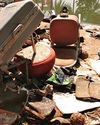
On June 3, Nine News’ Europe correspondent, Sophie Walsh, was approached by a man allegedly yelling religious phrases while making stabbing motions – he was later found to have a screwdriver on him – and grabbing her while she was doing a live cross on the streets of London. Hours later another Nine reporter Ben Avery and his cameraman Cade Thompson were forced to outrun a mob after they were confronted while on air.
Being belted with a police baton, assaulted with a screwdriver, tear gassed, or chased down the street by angry protesters doesn’t sound like a normal work day for most of us. But more and more often, foreign media correspondents are not only witnessing, but also becoming victims of violence in their attempts to report on global events as they happen.
But it’s not just incensed civilians that these journalists have to watch out for. Just days earlier, on June 1, Channel Seven US correspondent Amelia Brace was hit with a baton and her cameraman Tim Myers was struck in the chest by US police while covering the Black Lives Matter protests in Washington D.C. – despite identifying themselves as media. As they attempted to head for safety, the pair were hit by rubber bullets.
The scene unfolded on live TV, with the disturbing video quickly going viral and making headlines, not just in Australia but across the globe. “It was an absolutely terrifying experience,” Brace told Sunrise the next day.
“It’s not just about the media and the fact we were attacked while doing our job, but it was the fact that it was before curfew, so every single person at that protest had a legal right to be there.”
この記事は WHO の July 6, 2020 版に掲載されています。
7 日間の Magzter GOLD 無料トライアルを開始して、何千もの厳選されたプレミアム ストーリー、9,000 以上の雑誌や新聞にアクセスしてください。
すでに購読者です ? サインイン
この記事は WHO の July 6, 2020 版に掲載されています。
7 日間の Magzter GOLD 無料トライアルを開始して、何千もの厳選されたプレミアム ストーリー、9,000 以上の雑誌や新聞にアクセスしてください。
すでに購読者です? サインイン

JAYNE AZZOPARDI
THE NEWS PRESENTER HAS HER HANDS FULL AT WORK AND HOME

How to be a SOCIAL BUTTERFLY
Your guide to surviving the party season

GET FINANCIALLY FIT IN 2025
Kick those money goals in the New Year

BOXING DAY TSUNAMI - RUNNING FOR THEIR LIVES
TWO DECADES AFTER DISASTER STRUCK, ALYCE SUGDEN RECALLS HER HARROWING ESCAPE

A SAD GOODBYE
WHO PAYS TRIBUTE TO SOME OF THE STARS WE LOST THIS YEAR

THE END OF AN ERA
THERE WERE TEARFUL AND TERRIBLE GOODBYES FOR THESE CELEB COUPLES IN 2024

SHOCKS & SCANDALS
SOME OF THE BIGGEST STORIES OF THE YEAR WERE THE ONES THAT NO-ONE SAW COMING

BABY BOOM
IT WAS A BUMPER YEAR AS CELEBRITIES EXPANDED THEIR BROODS

A YEAR OF LOVE
FROM NEW ROMANCES TO WEDDING BELLS, THESE STARS MADE A SPLASH

THE YEAR THAT WAS
THE STORIES THAT HAD THE COUNTRY TALKING